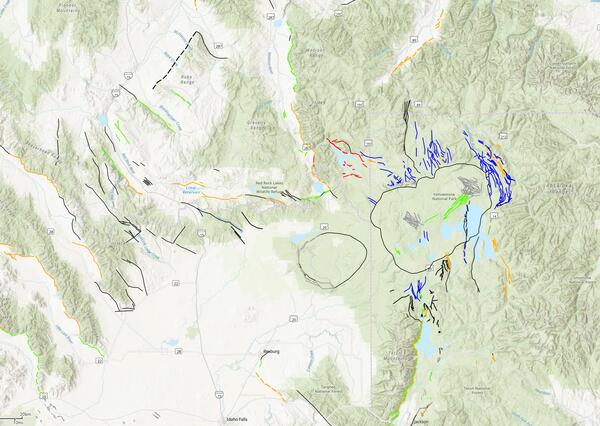Snapshot of QFaults for the area including Yellowstone National Park from https://www.usgs.gov/programs/earthquake-hazards/faults
Multimedia
Browse images and videos related to earthquakes and earthquake hazards.
Images

Snapshot of QFaults for the area including Yellowstone National Park from https://www.usgs.gov/programs/earthquake-hazards/faults

Seismic hazard model for Hawaii from 2021 showing peak ground acceleration where warmer colors are higher levels.
linkSeismic hazard model for Hawaii from 2021 showing peak ground acceleration where warmer colors are higher levels (Petersen and others, 2022).
Seismic hazard model for Hawaii from 2021 showing peak ground acceleration where warmer colors are higher levels.
linkSeismic hazard model for Hawaii from 2021 showing peak ground acceleration where warmer colors are higher levels (Petersen and others, 2022).
A cross section through the area of Anchorage, AK showing earthquakes at depths along with subduction model linework from Slab2 and inputs from the 2007 NSHM. The image shows the seismic catalog (for the 2023 NSHM seismic hazard model for Alaska; Powers and others, 2024) for the crust (yellow), interface (orange), and intraslab (red).
A cross section through the area of Anchorage, AK showing earthquakes at depths along with subduction model linework from Slab2 and inputs from the 2007 NSHM. The image shows the seismic catalog (for the 2023 NSHM seismic hazard model for Alaska; Powers and others, 2024) for the crust (yellow), interface (orange), and intraslab (red).

Aftershock Forecast Sequence-Specific Model Parameters equation
The probability distribution for the number of aftershocks, P(N), and the forecast can then be computed using the same procedures as for the generic model, using Pseq-spec(a) instead of Pgeneric(a).
Aftershock Forecast Sequence-Specific Model Parameters equation
The probability distribution for the number of aftershocks, P(N), and the forecast can then be computed using the same procedures as for the generic model, using Pseq-spec(a) instead of Pgeneric(a).
An example of Bayesian updating of productivity parameter (a-value) for the 2010 Mw 8.8 Maule, Chile, earthquake. Immediately following the earthquake, the SZ-GENERIC region-specific a-value distribution can be used.
An example of Bayesian updating of productivity parameter (a-value) for the 2010 Mw 8.8 Maule, Chile, earthquake. Immediately following the earthquake, the SZ-GENERIC region-specific a-value distribution can be used.
Screenshot of the Aftershock Forecast for an earthquake in California, showing the information box at the top of the forecast and the four tabs of forecast information.
Screenshot of the Aftershock Forecast for an earthquake in California, showing the information box at the top of the forecast and the four tabs of forecast information.
Videos
Computer simulation of shaking during the April 14, 2025 M5.2 Julian, CA earthquake. As the waves propagate away from the epicenter they interact with different geologic materials, which can slow down and amplify the shaking.
Computer simulation of shaking during the April 14, 2025 M5.2 Julian, CA earthquake. As the waves propagate away from the epicenter they interact with different geologic materials, which can slow down and amplify the shaking.
 USGS PAGER during the Magnitude 7.7 2025 Mandalay, Burma (Myanmar) Earthquake
USGS PAGER during the Magnitude 7.7 2025 Mandalay, Burma (Myanmar) Earthquake
Dr. William Yeck is a seismologist with the USGS National Earthquake Information Center. He explains the importance of PAGER during the magnitude 7.7 2025 Mandalay, Burma (Myanmar) Earthquake.
Dr. William Yeck is a seismologist with the USGS National Earthquake Information Center. He explains the importance of PAGER during the magnitude 7.7 2025 Mandalay, Burma (Myanmar) Earthquake.
Ammonia or ammonium? What’s the difference? In water, ammonia (NH3) and ammonium (NH4+) exist together in an equilibrium that depends on pH and temperature. As the temperature or pH rise, ammonia (NH3) becomes more abundant. This is important because ammonia is more toxic than ammonium.
Ammonia or ammonium? What’s the difference? In water, ammonia (NH3) and ammonium (NH4+) exist together in an equilibrium that depends on pH and temperature. As the temperature or pH rise, ammonia (NH3) becomes more abundant. This is important because ammonia is more toxic than ammonium.
USGS Scientist, Bob deGroot, briefly explains what happened during the magnitude 7.0 earthquake that occurred offshore of Mendocino, CA, on December 5, 2024.
The event occurred in an area called the Triple Junction, where the Pacific, Juan de Fruca, and North American tectonic plates meet.
USGS Scientist, Bob deGroot, briefly explains what happened during the magnitude 7.0 earthquake that occurred offshore of Mendocino, CA, on December 5, 2024.
The event occurred in an area called the Triple Junction, where the Pacific, Juan de Fruca, and North American tectonic plates meet.
USGS Scientist, Bob deGroot, briefly explains what happened during the magnitude 7.0 earthquake that occurred offshore of Mendocino, CA, on December 5, 2024.
The event occurred in an area called the Triple Junction, where the Pacific, Juan de Fruca, and North American tectonic plates meet.
USGS Scientist, Bob deGroot, briefly explains what happened during the magnitude 7.0 earthquake that occurred offshore of Mendocino, CA, on December 5, 2024.
The event occurred in an area called the Triple Junction, where the Pacific, Juan de Fruca, and North American tectonic plates meet.
 ShakeMovie Animation: 1989 M6.9 Loma Prieta Earthquake
ShakeMovie Animation: 1989 M6.9 Loma Prieta Earthquake
The 1989 Loma Prieta earthquake, measuring magnitude 6.9, was the strongest to hit the San Francisco Bay Area since the Great San Francisco earthquake of 1906. Although it provided extensive data on ground shaking, the available observations don’t fully capture all the quake's important features.
The 1989 Loma Prieta earthquake, measuring magnitude 6.9, was the strongest to hit the San Francisco Bay Area since the Great San Francisco earthquake of 1906. Although it provided extensive data on ground shaking, the available observations don’t fully capture all the quake's important features.
Audio
USGS seismologist Andrew Michael talks about the remote location of the 1992 Landers earthquake and how researchers were able to use satellite data to better see the quake’s impacts.
USGS seismologist Susan Hough talks about her role following the 1992 Landers earthquake and seismic monitoring stations in Southern California.









